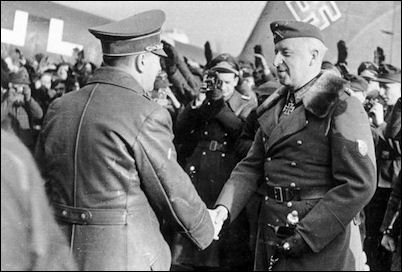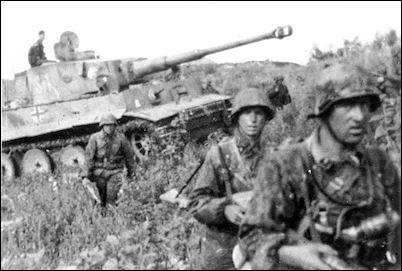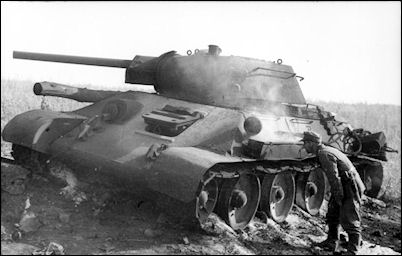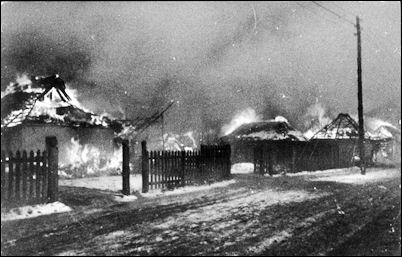![]()

The Kursk Gamble
After the catastrophe at Stalingrad, the German Army in southern Russia had been forced to fall back in order to regroup, dig in and stabilize the whole Front. Gone was the notion of capturing the city named after Russia's leader or the rich oil fields deep in the Caucasus.
Hitler was now up against a Russian Army growing stronger by the day. His nemesis, Josef Stalin, could draw from a giant human reservoir to fill his ranks. By contrast, the failed attacks at Moscow, Stalingrad, and in the Caucasus, had cost Hitler two million men, sapping over half his strength in Russia. As a result, the call up had been sounded in Germany for young men formerly exempt from military service, and for men up to 50 years old, soldiers of the First World War, now needed to fill out the ranks.
Despite it all, Hitler yearned to go back on the offensive in Russia as soon as possible, hoping to seize the initiative and somehow turn things around. By the spring of 1943, he had massed a half-million soldiers near Kursk, located in the Eastern Ukraine. Facing them was a Russian force twice as large, including the Red Army's most experienced troops, along with the same units who had just beaten the Germans at Stalingrad.
ADVERTISEMENT Undaunted, Hitler eyed a daring plan for a Blitzkrieg attack reminiscent of the early days of Operation Barbarossa when huge Russian formations had been surprised by motorized German troops and tanks, then surrounded and captured. Called Operation Citadel, the new plan involved a two-pronged attack against the expansive Russian bulge in the lines west of Kursk. The German Ninth Army led by General Kluge would attack from the north while Field Marshal Manstein's Fourth Panzer Army attacked from the south. The two armies would slice through the bulge, meet up in the middle at Kursk, then turn westward and smash the now-isolated Red Army units.
But there were some big problems for Hitler at this point. First, the element of surprise was gone. The Russians were now watching Hitler's every move. They also benefited enormously from good intelligence including the decoded messages of the Army High Command, passed on to them by the British who had broken the Wehrmacht's secret cipher code. This meant that all of the radioed instructions from the High Command to German field commanders at Kursk and elsewhere were known to the Russians.
The Germans had also misjudged the capacity and quality of Russian war production. The Russians were now fully utilizing factories they had relocated to the safety of eastern Russia beyond the range of Göring's Luftwaffe. As a result, wide-eyed German field commanders watched in amazement as fresh divisions streamed into battle alongside powerful new T-34 tanks with sloped armored plating that caused German anti-tank shells to bounce off harmlessly. Moreover, the Germans found the Russians could produce huge numbers of the tanks, along with state-of-the-art warplanes, top notch artillery and highly effective mobile rocket-grenade launchers.
Additionally, the Russian Army command staff of 1943 was a far cry from the disorganized rabble the Germans had nearly beaten two years earlier. Russian generals such as Georgi Zhukov had now proven they were a match for any of Hitler's commanders. They had learned how to win. In the meantime, Stalin had learned to trust the judgment of Zhukov and other similarly-successful Russian commanders, allowing them to make important strategic decisions on their own.
By contrast, Hitler had his hand in nearly all aspects of every decision, unwisely functioning both as Supreme Commander of the German Armed Forces and as Commander-in-Chief of the German Army, responsible for day-to-day operational command of his troops on all fronts. And it was evident to those around him that he had taken on too much. He was plainly worn out by the burden, and by the unimagined consequences of piloting the German Army into one costly failure after another, ultimately endangering the very survival of his thousand-year Reich. The magnitude of that stress had begun to show. Nazi political cronies from the old days, upon seeing Hitler now, were shocked by his stooped, ashen-faced appearance. He looked like a man in his sixties, instead of 54, his actual age, with hands that trembled so badly at times that his tea cup clattered loudly against its saucer plate.
And now came indecision.
His generals knew of course that he didn't like to hear their opinions but they provided them to Hitler anyway, mindful of their frontline soldiers. When they examined the Kursk scenario they saw great danger and even suggested postponing the offensive altogether. This was prompted in part by critical delays in armaments deliveries, particularly the new Tiger I super-tanks, expected to outmatch the omnipresent Russian T-34s.
Beset by serious equipment delays, but still yearning to attack, Hitler couldn't decide whether or not to give the final go-ahead for Operation Citadel. The resulting delay, eventually lasting ten weeks, only made things worse, giving the Russians adequate time to perfect their defenses. This included three defensive rings around Kursk with miles of anti-tank ditches and traps, dense mine fields and barbed wire entanglements. The Russians also took the opportunity to increase their numerical advantage in men, tanks, planes and artillery for the big showdown.
Meanwhile, the Germans struggled to outfit 17 tank divisions by rushing newly built Panther and Tiger tanks straight from the assembly line to the battlefield, even though the Tigers were largely untested in field conditions, still had unresolved mechanical flaws, and German tank crews at Kursk had not trained in them.
By late June, decision time had finally come for Hitler. Satisfied that sufficient equipment and troops were in place, Hitler set Monday, July 5th, as the launch date for Operation Citadel. British intelligence, along with Russian spies, diligently tipped off Marshal Zhukov with the day and time of the attack. Zhukov reacted by beating Hitler to the punch via a massive artillery bombardment at 3:20 a.m. on July 5th, precisely ten minutes before Citadel was scheduled to begin, thereby knocking the Germans off-stride during their opening moves.
Nevertheless, the Germans pressed forward and one of the largest battles of World War II now unfolded as a million-and-a-half soldiers, 6,000 tanks and 4,000 planes clashed around Kursk. The original German plan to cut through the Russian bulge from the north and south met with little success. Kluge's Ninth Army only advanced four miles southward before it was bogged down by the effective anti-tank defenses, while Manstein's Fourth Panzer Army only got eight miles to the north.
The sweeping Barbarossa-style armored movements that Hitler hoped for were proving impossible. Russian defenses were simply too strong. Additionally, the Tiger tanks proved mechanically unreliable on the battlefield, and a majority dropped out within the first few days. The Germans would therefore have to rely on their smaller Panzer tanks, which they already knew were outgunned by the mighty Russian T34s. The Germans were also relying on their Stuka dive bombers to help knock out the Russian tanks. But the slow moving Stukas proved to be an easy target for the state-of-the-art Russian Shturmovik fighters which soon gained air supremacy over the entire battlefield.
As a result, the worst-case scenario emerged for German tank commanders and infantrymen at Kursk, a bloody battle of attrition – exactly what Hitler's generals had feared the most – and exactly what the Russians wanted.
Bold moves were needed to stave off a costly stalemate. And so Manstein sent three Waffen-SS tank divisions rolling eastward on Sunday, July 11th. The 700 Panzers were supposed to probe for a weak spot behind the main Russian defenses. Purely by accident, they met head-on with a reserve formation of 850 tanks from the Russian Fifth Guards Tank Army. This resulted in the largest single tank battle ever fought as the two sides blasted away at each other at close range for eight hours non-stop, jousting at times like knights from medieval days. There was no clear winner in the tumultuous engagement and both sides gradually broke off, then brought in reinforcements just to maintain their positions.
For Hitler, the outlook at Kursk was getting bleaker by the day. Continued fighting would only prolong the battle of attrition which the numerically superior, well-supplied and well-commanded Russians would surely win.
Worse for Hitler, he was now confronted by staggering news from elsewhere. British and American troops had just landed on the island of Sicily, off the coast of Italy, opening a whole new front in the war. News of that invasion, coming on top of the dismal reports from Kursk, caused Hitler to call off Operation Citadel on July 13th. Thus far, the Kursk gamble had cost the Germans 70,000 men, nearly 3,000 tanks and 1,400 planes, losses that would prove irreplaceable. Russian losses were slightly higher but they could recoup.
For the Russians, the Battle of Kursk was a major turning point in the war, and a great turning point in their nation's history. At long last, they had broken the back of the German Army in Russia and could begin to expel Hitler's soldiers and SS men from the Motherland, knowing now that the Third Reich was going down to defeat.
Seizing the momentum, which they would never relinquish, the Russians began a general advance along a thousand-mile front, pushing back the Germans at every turn. One by one, Russian cities which had been under murderous Nazi domination for two years were liberated by the Red Army, including Orel, Kharkov, Smolensk and Kiev.
Observing the scope of Nazi devastation up close only intensified the hatred that individual Russian soldiers felt for the Germans as they ventured westward in the pursuit of Hitler's troops. That devastation worsened as the Germans withdrew while enacting a scorched earth policy to leave absolutely nothing of value behind for the Russians. This included the destruction of all bridges, railways, crops, live stock, homes and commercial buildings. Russian civilians caught up in the mayhem suffered terribly. Russian soldiers who found their bodies vowed bloody vengeance.
For Adolf Hitler, the much-vaunted dream of establishing Lebensraum in Russia was finally over. Now, he needed to figure out what to do about Italy and the new Southern Front in Europe before things slipped out of control there as well.
Copyright © 2010 The History Place™ All Rights Reserved
![]()
NEXT SECTION - Allies Invade Italy
The Defeat of Hitler Index
The History Place Main Index Page
Terms of use: Private home/school non-commercial, non-Internet re-usage only is allowed of any text, graphics, photos, audio clips, other electronic files or materials from The History Place.



